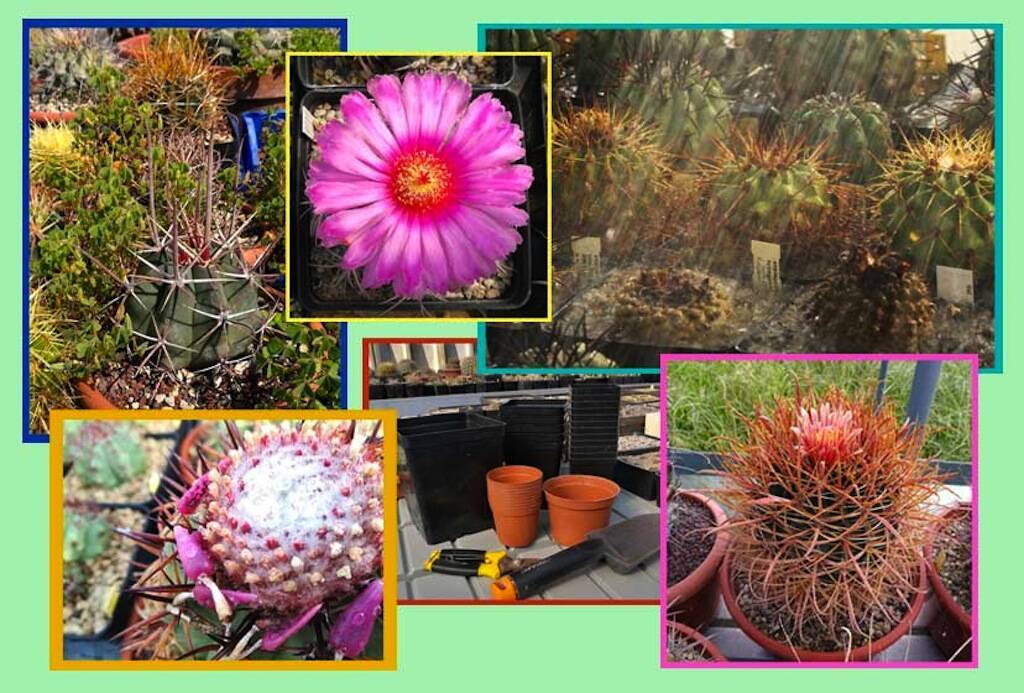I have discussed in various articles on this site of the basic factors for growing cacti and succulents, particularly those collected in the Cultivation category. This post intends to be a kind of summary “map” organized by seasons (seasonal care), indicating what you have to do at each time of year. In the following article, I review everything that needs to be done in terms of watering, fertilizing, repotting, exposure, etc. – season by season, to best grow cacti and succulent plants in general. This guide is thought to be a practical “vademecum” at a glance (but each topic can be explored in depth thanks to the appropriate internal links) of what is useful and recommended to do in spring, summer, fall and winter.
In short, a kind of handbook to keep in mind every time to organize work, whether you have a greenhouse or a terrace, a balcony or even only a windowsill. Let’s see everything in this article. (…)
Spring
Let’s start our “seasonal care map” from Spring. Between mid-February and early March, many succulents begin to awaken from their winter slumber. The days become longer and the sun begins to warm a little more. We can notice the resumption of growth in some cacti and succulents simply by taking a good look at the apex, from which new spines and, in the case of succulents, new leaves will begin to sprout. In many cases, we can also see the presence of buds, particularly on genera such as Ancistrocactus, Mammillaria, Stenocactus (Echinofossulocactus), Strombocactus and Turbinicarpus.
An article and photo gallery with early blooms can be found here.
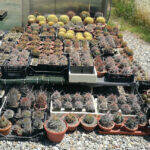
At this time of year I do some preventive treatments, mainly fungicide-based, since rising temperatures, when combined with higher humidity, can promote the onset of fungal diseases. So in early March I give a spray with water and copper oxychloride (the so-called “cupric” with its characteristic blue colour, which is also produced in an uncolored formula by Caffaro). I usually follow up a first spray, given strictly on a sunny day (but not under sunrays!), with a second one at a 15-day interval. The plants do stain slightly, but they will clear up after the first real waterings. I don’t give water (I mean watering the potting soil) before the end of March, even if the plants show signs of recovery. I prefer to be cautious and start watering only when the temperatures have stabilized and the plants are all growing.
Also as a preventive measure, spraying with a product against plant pests can be useful. About this, Neem oil is recommended, which is naturally based and gives a very high protection. For specific products against red spider mite and mealybug, the best is to wait a few more months, when temperatures will be higher and may, eventually, favour the arrival of these insects.
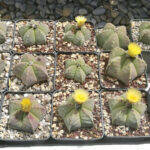
In this period of year is fundamental to start giving as much air to the plants as possible. If the lows no longer drop below freezing, except sporadically, it’s a good idea to partially open the greenhouse or uncover plants kept under “tnt” (nonwoven fabric) during the winter, while still keeping them out of the rain. Temperature changes are not a problem: even in nature, plants are subject to them and indeed benefit from them. From the end of February I generally raise the side sheets of my greenhouse by half a meter, so to let my plants having a good air circulation, and then raise them within a month or so. From the end of April, I also leave the front and back doors of the structure wide open, so as to ensure as much air circulation as possible.
Spring, or rather the end of winter, is a great time for repotting: the plants are about to wake up and there is still time before watering. We can then safely repot the plants that need it in the new potting soil, having so much time in front of us (at least a month) for any root wounds to heal before the substrate receives its first watering. If you can keep some plants in full sun, outside the greenhouse or on terraces or balconies without any cover, this is the best time to accustom cacti and succulents to direct sunlight again. The March sun is not yet strong, and plants that are already sufficiently formed (so not seedlings!) have time to get used to the bright light without burning their epidermis. Never put a plant in direct sun during the hottest months, such as July or August, especially if it has been kept in a greenhouse or otherwise covered by tarps or netting, or under the shelter of other plants. As an added caution, a light shade net can be useful for a few weeks if placed over the plants we put in direct sun in March. At the time of April, the net can be removed and the plants will not run the risk of sunburn.
The first waterings can be done, also depending on weather conditions, from late March onward (at least where I grow, in northern Italy). The first passes are done with water alone or with water and a systemic fungicide. Fertilizations, on the other hand, can be done from the third or fourth watering onward, when the root system of the plants is back in full working order.
Finally, again in spring, sowing can be done. Let’s say from when the minimum temperatures are no longer below 12/14 celsius degrees.
Summer
Seasonal care begin to vary with the arrival of summer. From June through mid-August, cacti and most succulents are in full bloom. Blooms also abound during this period, when succulents want as much light and as much air as possible. In fact, succulents are able to tolerate very high temperatures (even up to 50 degrees), as long as they have air and water available when needed.

Plenty of watering can be done during this period, making sure that the water soaks the entire soil loaf and allowing the substrate to dry well between waterings. Plants kept outdoors can take rain even for several days in a row: if the soil is correct, they will not rot. Between June and August it is also useful to do some fertilizing: during the entire growing season, from March to September, I fertilize a maximum of three times. Watering can also be daily if the soil is very draining and if we are in warm, windy areas. In North Italy I have noticed that a good watering rate is once every ten days. This way the plants grow slowly but in a balanced way and I don’t run the risk of rot. It is different for seedlings, which I water once a week to encourage their development.
When temperatures rise it is possible for mealybugs and red spider mites to make their appearance. Treatment by spraying with specific products may be useful, especially as a preventive measure. However, at this time of the year avoid spraying with copper oxychloride fungicide, which should not be given during the growth phase because it can slow or stop vegetation. In summer it is good to be careful with plants that are kept in direct sun, that is not in a greenhouse or not sheltered: the sun could burn plants that are too young or not yet accustomed to direct rays, and high is the danger of hailstorms.
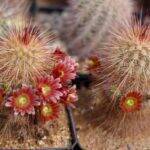
Watch out for the months of July and August: when temperatures are very high (especially the lows, to the point that the range between day and night is very small) many succulents go into aestivation, they slow down or stop growing altogether to conserve energy. Observation is key here to see if a plant has stopped producing new spines and if the apex tends not to develop. If plants are into aestivation, it’s a good idea to reduce or to suspend watering. In fact, in this condition the plant does not vegetate and therefore does not “drink.” If we water, we risk leaving the roots submerged in a soggy substrate for too many days, with the risk of root or collar rot setting in. Similarly, there are some genera, particularly those native to Chile, such as Copiapoa and Neoporteria, but also non-Chilean plants, such as Pediocactus and Sclerocactus, that stunt growth from July through August. These plants should be stopped watering altogether from the end of June, then resumed in September and, in moderation, watered during October as well.
Fall
Like spring, autumn is a delicate season for succulent plants. Here are some seasonal care for this time of the year. The days begin to shorten significantly from the end of August, and temperatures – usually – begin to drop. Humidity, on the other hand, remains high, especially at night. Plants, with the exception of some genera such as Copiapoa and Pediocactus, slow down their vegetation. It will be essential to observe cacti and succulents well to accommodate their needs and begin to reduce watering.
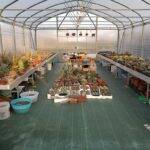
Based on the cold and wet climate in my growing area, in northern Italy, I usually water a couple of times during the month of September, and then suspend watering altogether until vegetative growth resumes (March). With the last waterings, adding fertilizer and a systemic fungicide against Fusarium, as a preventive measure, may be useful. Also for preventive purposes, in October or November it’s good to spray all plants with copper oxychloride (I usually do a first pass, followed by a second one a fortnight apart). Crucial, as always, is air: until the minimum temperatures drop drastically and steadily (say to 4 or 5 celsius degrees), I leave the greenhouse open, limiting myself to bringing home the few cold-intolerant species I grow, such as Melocactus, Discocactus, some Euphorbia and Adenium.
From late September, early October, I bring almost all plants back inside the greenhouse, to prevent them from getting rain. In fact, cacti must have time to prepare for the dry season by reducing fluids inside the stem and letting the substrate dry out before the first cold weather arrives. I do not repot in the fall unless strictly necessary (e.g., in the case of a plant in distress). I prefer to leave the plants alone at the delicate time of slowing and stalled vegetation.
Several genera flower in this season: among cacti, Ariocarpus, and among succulents, Lithops.
Winter
This is the quietest season: our seasonal care will therefore reduced to a minimum. Plants are in stasis, not growing, do not need to be watered (except for winter-growing species) and do not need to be fertilized. During winter there is also no need for fungal or pest treatments: if the plants are healthy, preventive treatments in the fall and spring are enough. In the northern hemisphere, from the end of October through the end of January, cacti go into stasis: they stop growing to regain energy and prepare for the new growing season. The substrate should be kept perfectly dry and the plants should be protected from rain. Those who have a greenhouse have no problem. Those who grow on balconies or terraces, on the other hand, can shelter the plants in cold, rain-sheltered areas. Even a garage may be fine, although a minimum of light is always good to ensure even for plants in complete stasis.
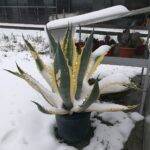
Cold and winter dormancy are essential for the balanced growth of cacti and for their flowering. Many species are quite cold-hardy and can be kept outside even in northern Italy: for example, Opuntia, Pediocactus, Agaves. If kept dry, almost all kinds of cacti can tolerate very low temperatures, even around zero celsius degrees minimum. Also growing some Euphorbia and other less hardy plants, I have found a compromise; in winter, in my greenhouse I have a thermostat that trips when the minimums goes below 4 celsius degrees.
Winter is a great time for repotting: the plants are in stasis and are not affected because of any root cuts. Also, if we repot in January/February, we will be assured that any wounds to the root system can heal in time for the first watering, which will come no earlier than mid-March.
SUBSCRIBE TO THE SITE – If you liked this article, subscribe to the site to have access to all the contents for one year or three months depending on the formula you choose. Here you will find terms and conditions.
SUBSCRIBE TO THE NEWSLETTER – If you want to receive the free newsletter every time new content is published (even if you have not subscribed to the site), fill in the fields at this link!
Correlated articles
Watering cacti and succulents: when and how
How to repot cacti and succulent plants
Substrates for cacti and succulents
The correct soil: the materials you can use
© The texts, videos, photos and graphic elaborations of the site “Il fiore tra le spine” are original material and are covered by copyright. It’s forbidden to reproduce them in any way.


